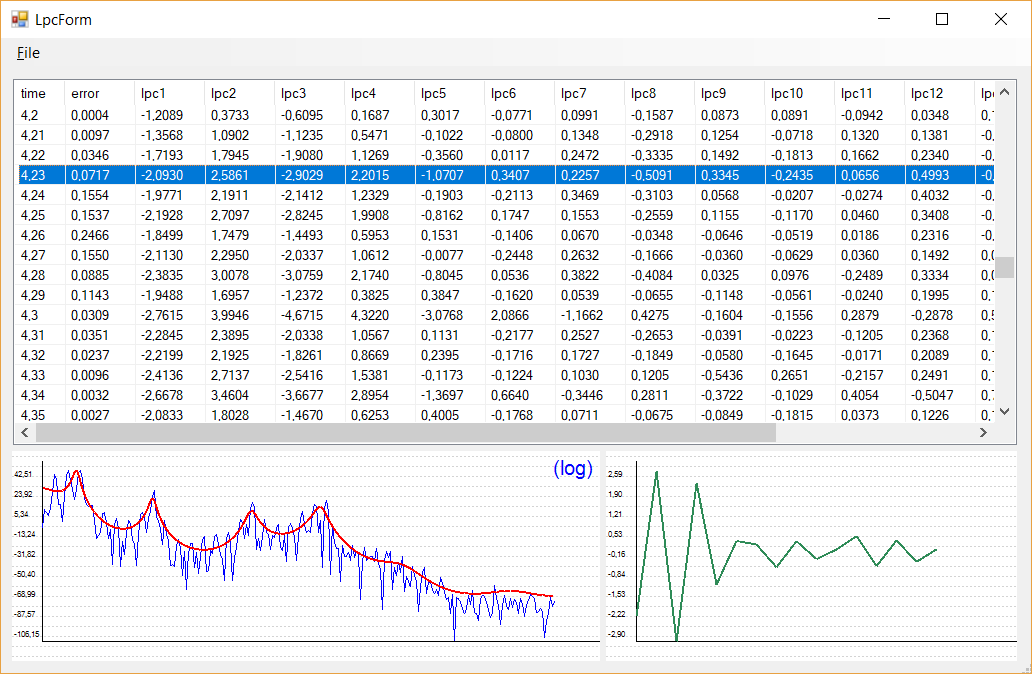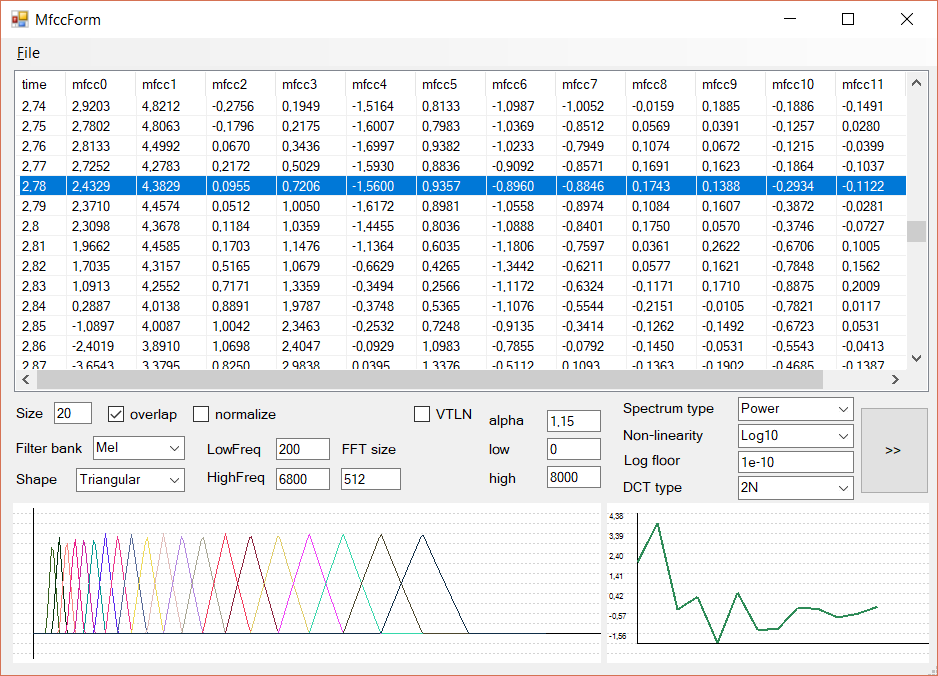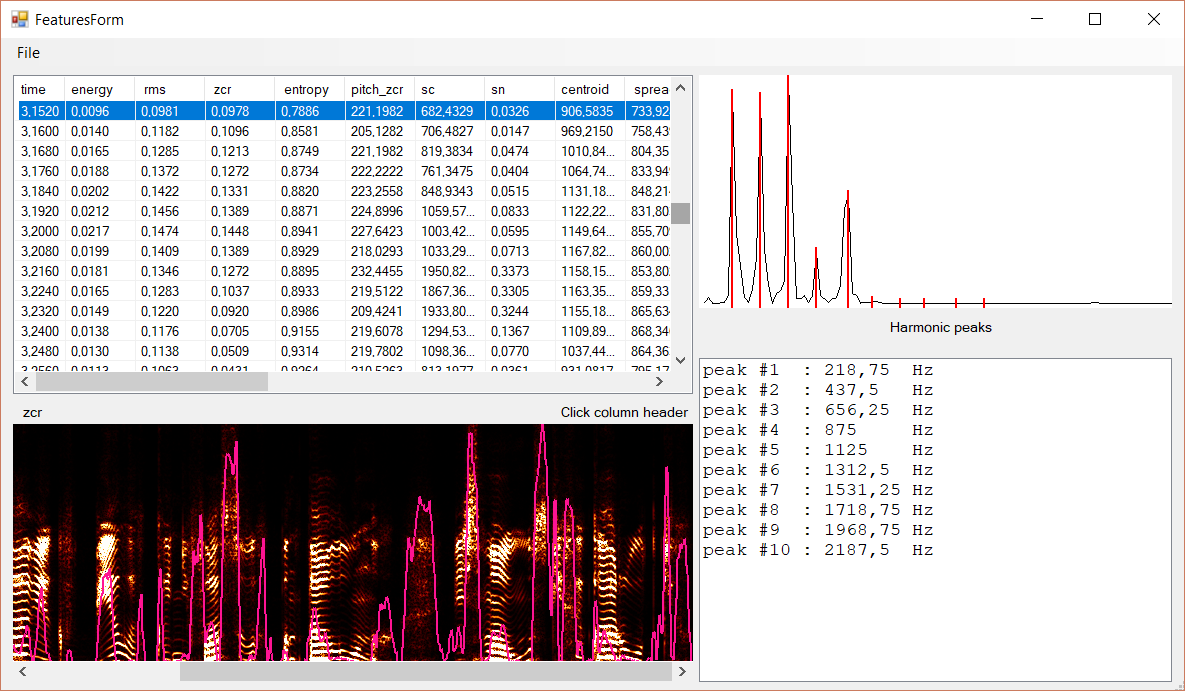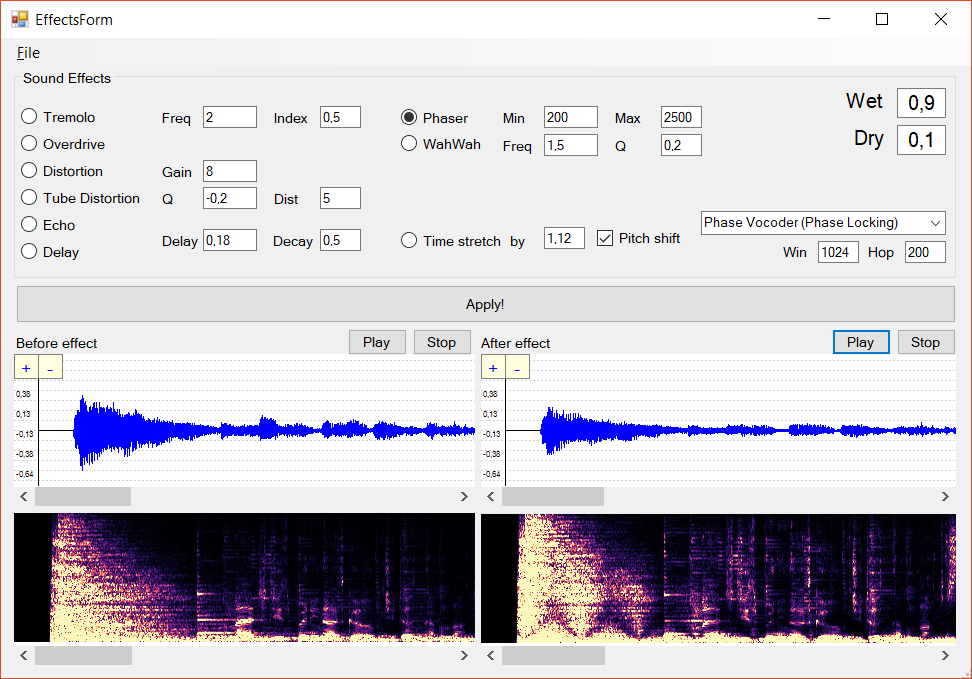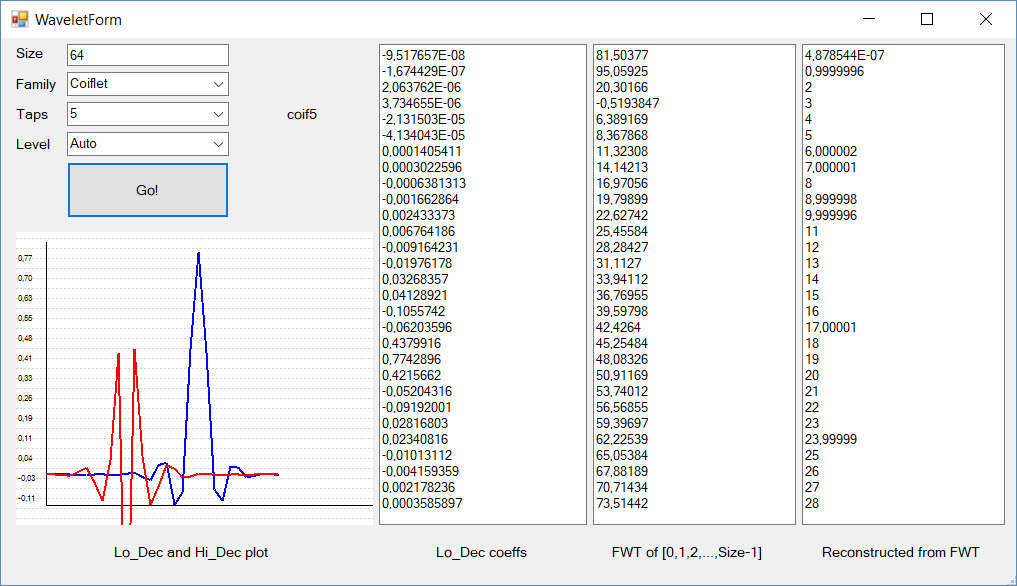NWaves

NWaves is a .NET DSP library with a lot of audio processing functions.
Releases
NWaves is available on NuGet:
PM> Install-Package NWaves
New version 0.9.6 is out! Faster, smarter, more features. Read about changes here
Watch survey video | Playlist | Samples | Benchmarks | Playground (code)
Main features
- [x] major DSP transforms (FFT, DCT, MDCT, STFT, FWT, Hilbert, Hartley, Mellin, cepstral, Goertzel)
- [x] signal builders (sine, white/pink/red/Perlin noise, awgn, triangle, sawtooth, square, pulse, ramp, ADSR, wavetable)
- [x] basic LTI digital filters (moving average, comb, Savitzky-Golay, pre/de-emphasis, DC removal, RASTA)
- [x] FIR/IIR filtering (offline and online), zero-phase filtering
- [x] BiQuad filters (low-pass, high-pass, band-pass, notch, all-pass, peaking, shelving)
- [x] 1-pole filters (low-pass, high-pass)
- [x] IIR filters (Bessel, Butterworth, Chebyshev I & II, Elliptic, Thiran)
- [x] basic operations (convolution, cross-correlation, rectification, amplification, fade / crossfade)
- [x] block convolution (overlap-add / overlap-save offline and online)
- [x] basic filter design & analysis (group delay, zeros/poles, BP, BR, HP from/to LP, SOS, combining filters)
- [x] state space representation of LTI filters
- [x] FIR filter design: frequency sampling, window-sinc, equiripple (Remez / Parks-McClellan)
- [x] IIR filter design: IirNotch / IirPeak / IirCombNotch / IirCombPeak
- [x] non-linear filters (median filter, distortion effects, bit crusher)
- [x] windowing functions (Hamming, Blackman, Hann, Gaussian, Kaiser, KBD, triangular, Lanczos, flat-top, Bartlett)
- [x] periodograms (Welch / Lomb-Scargle)
- [x] psychoacoustic filter banks (Mel, Bark, Critical Bands, ERB, octaves) and VTLN warping
- [x] customizable feature extraction (time-domain, spectral, MFCC, PNCC/SPNCC, LPC, LPCC, PLP, AMS)
- [x] preconfigured MFCC extractors: HTK (MFCC-FB24), Slaney (MFCC-FB40)
- [x] LPC conversions: LPC<->cepstrum, LPC<->LSF
- [x] feature post-processing (mean and variance normalization, adding deltas) and CSV serialization
- [x] spectral features (centroid, spread, flatness, entropy, rolloff, contrast, crest, decrease, noiseness, MPEG7)
- [x] harmonic features (harmonic centroid and spread, inharmonicity, tristimulus, odd-to-even ratio)
- [x] time-domain characteristics (rms, energy, zero-crossing rate, entropy)
- [x] pitch tracking (autocorrelation, YIN, ZCR + Schmitt trigger, HSS/HPS, cepstrum)
- [x] chromagram (chroma feature extractor)
- [x] time scale modification (phase vocoder, PV with identity phase locking, WSOLA, PaulStretch)
- [x] simple resampling, interpolation, decimation
- [x] bandlimited resampling
- [x] wavelets: haar, db, symlet, coiflet
- [x] polyphase filters
- [x] noise reduction (spectral subtraction, sciPy-style Wiener filtering)
- [x] sound effects (echo, tremolo, wahwah, phaser, chorus, vibrato, flanger, pitch shift, morphing, robotize, whisperize)
- [x] 3D/Stereo audio (stereo panning, stereo and ping-pong delay, ITD-ILD, binaural panning)
- [x] envelope following
- [x] dynamics processing (limiter / compressor / expander / noise gate)
- [x] harmonic/percussive separation
- [x] Griffin-Lim algorithm
- [x] Karplus-Strong synthesis
- [x] PADSynth synthesis
- [x] adaptive filtering (LMS, NLMS, LMF, SignLMS, RLS)
- [x] simple modulation/demodulation (AM, ring, FM, PM)
- [x] simple audio playback and recording
Philosophy of NWaves
NWaves was initially intended for research, visualizing and teaching basics of DSP and sound programming.
Usually, DSP code is quite complicated and difficult to read, because it's full of optimizations (which is actually a very good thing). NWaves project aims in particular at achieving a tradeoff between good understandable code/design and satisfactory performance. Yet, the main purpose of this lib is to offer the DSP codebase that would be:
- easy to read and understand
- easy to incorporate into existing projects
- easy to port to other programming languages and frameworks
- even possibly treated as the DSP/audio textbook.
According to NWaves architecture, there are following general reusable building blocks for all kinds of DSP tasks:
Transforms | Filters | Signal builders | Feature extractors
Quickstart
Working with 1D signals
// Create signal from samples repeated 100 times
float[] samples = new [] { 0.5f, 0.2f, -0.3f, 1.2f, 1.6f, -1.8f, 0.3f, -0.2f };
var s = new DiscreteSignal(8000, samples).Repeat(100);
var length = s.Length;
var duration = s.Duration;
var echoSignal = s + s.Delay(50);
var marginSignal = s.First(64).Concatenate(s.Last(64));
var repeatMiddle = s[400, 500].Repeat(10);
var mean = s.Samples.Average();
var sigma = s.Samples.Average(x => (x - mean) * (x - mean));
var normSignal = s - mean;
normSignal.Attenuate(sigma);
Signal builders
DiscreteSignal sinusoid =
new SineBuilder()
.SetParameter("frequency", 500.0/*Hz*/)
.SetParameter("phase", Math.PI / 6)
.OfLength(1000)
.SampledAt(44100/*Hz*/)
.Build();
DiscreteSignal noise =
new RedNoiseBuilder()
.SetParameter("min", -2.5)
.SetParameter("max", 2.5)
.OfLength(800)
.SampledAt(44100)
.DelayedBy(200)
.Build();
DiscreteSignal noisy =
new SineBuilder()
.SetParameter("min", -10.0)
.SetParameter("max", 10.0)
.SetParameter("freq", 1200.0/*Hz*/)
.OfLength(1000)
.SampledAt(44100)
.SuperimposedWith(noise)
.Build();
Signal builders can also act as real-time generators of samples:
SignalBuilder lfo =
new TriangleWaveBuilder()
.SetParameter("min", 100)
.SetParameter("max", 1500)
.SetParameter("frequency", 2.0/*Hz*/)
.SampledAt(16000/*Hz*/);
//while (...)
{
var sample = lfo.NextSample();
//...
}
Signals and wave files:
WaveFile waveContainer;
// load
using (var stream = new FileStream("sample.wav", FileMode.Open))
{
waveContainer = new WaveFile(stream);
}
DiscreteSignal left = waveContainer[Channels.Left];
DiscreteSignal right = waveContainer[Channels.Right];
// save
var waveFileOut = new WaveFile(left);
using (var stream = new FileStream("saved_mono.wav", FileMode.Create))
{
waveFileOut.SaveTo(stream);
}
var waveFileStereo = new WaveFile(new [] { left, right });
using (var stream = new FileStream("saved_stereo.wav", FileMode.Create))
{
waveFileStereo.SaveTo(stream);
}
Transforms
For each transform there's a corresponding transformer object.
Each transformer object has Direct() and Inverse() methods.
FFT
// Complex FFT transformer:
var fft = new Fft(1024);
// Real FFT transformer (faster):
var rfft = new RealFft(1024);
float[] real = signal.First(1024).Samples;
float[] imag = new float [1024];
// in-place complex FFT
fft.Direct(real, imag);
// ...do something with real and imaginary parts of the spectrum...
// in-place complex IFFT
fft.Inverse(real, imag);
// post-processed FFT:
var magnitudeSpectrum =
fft.MagnitudeSpectrum(signal[1000, 2024]);
var powerSpectrum =
fft.PowerSpectrum(signal.First(1024), normalize: false);
var logPowerSpectrum =
fft.PowerSpectrum(signal.Last(1024))
.Samples
.Select(s => Scale.ToDecibel(s))
.ToArray();
// real FFT transforms real-valued signal to complex-valued spectrum:
rfft.Direct(real, real, imag); // real -> (real, imag)
rfft.Inverse(real, imag, real); // (real, imag) -> real
var magnitudeSpectrum =
rfft.MagnitudeSpectrum(signal[1000, 2024]);
var powerSpectrum =
rfft.PowerSpectrum(signal.First(1024), normalize: false);
// ...
Lot of methods in NWaves have overloaded versions with output buffers as parameters. So reuse memory whenever possible:
float[] spectrum = new float[1024];
for (var i = start; i < end; i += step)
{
rfft.MagnitudeSpectrum(signal[i, i + 1024], spectrum);
// ...
// do something with spectrum
}
STFT
// Short-Time Fourier Transform:
var stft = new Stft(1024, 256, WindowTypes.Hamming);
var timefreq = stft.Direct(signal);
var reconstructed = stft.Inverse(timefreq);
var spectrogram = stft.Spectrogram(signal);
Cepstral transform
// Cepstral transformer:
var ct = new CepstralTransform(24, fftSize: 512);
// complex cepstrum
ct.Direct(input, output);
// or
var delay = ct.ComplexCepstrum(input, output);
// real cepstrum
ct.RealCepstrum(input, output);
// inverse complex cepstrum
ct.InverseComplexCepstrum(output, input, delay: delay);
Wavelets
var fwt = new Fwt(192, new Wavelet("db5"));
// or
//var fwt = new Fwt(192, new Wavelet(WaveletFamily.Daubechies, 5));
var output = new float[192];
var reconstructed = new float[192];
fwt.Direct(input, output);
fwt.Inverse(output, reconstructed);
Operations:
// convolution
var conv = Operation.Convolve(signal, kernel);
var xcorr = Operation.CrossCorrelate(signal1, signal2);
// block convolution
var filtered = Operation.BlockConvolve(signal, kernel, 4096, FilteringMethod.OverlapAdd);
// periodogram evaluation
var periodogram = Operation.Welch(signal, 2048, 1024);
var pgram = Operation.LombScargle(x, y, freqs);
// resampling
var resampled = Operation.Resample(signal, 22050);
var interpolated = Operation.Interpolate(signal, 3);
var decimated = Operation.Decimate(signal, 2);
var updown = Operation.ResampleUpDown(signal, 3, 2);
// time scale modification
var stretch = Operation.TimeStretch(signal, 0.7, TsmAlgorithm.Wsola);
var cool = Operation.TimeStretch(signal, 16, TsmAlgorithm.PaulStretch);
// envelope following
var envelope = Operation.Envelope(signal);
// peak / rms normalization
var peakNorm = Operation.NormalizePeak(signal, -3/*dB*/);
var rmsNorm = Operation.NormalizeRms(signal, -3/*dB*/);
var rmsChanged = Operation.ChangeRms(signal, -6/*dB*/);
// rectification
var halfRect = Operation.HalfRectify(signal);
var fullRect = Operation.FullRectify(signal);
// spectral subtraction
var clean = Operation.SpectralSubtract(signal, noise);
// crossfade
var crossfaded = song1.Crossfade(song2, 0.05/*sec*/);
Filters and effects:
var maFilter = new MovingAverageFilter(7);
var smoothedSignal = maFilter.ApplyTo(signal);
var frequency = 800.0/*Hz*/;
var notchFilter = new BiQuad.NotchFilter(frequency / signal.SamplingRate);
var notchedSignal = notchFilter.ApplyTo(signal);
// filter analysis:
var transferFunction = new TransferFunction(new [] { 1, 0.5, 0.2 }, new [] { 1, -0.8, 0.3 });
var filter = new IirFilter(transferFunction);
// we can also write this:
// var filter = new IirFilter(new [] { 1, 0.5, 0.2 }, new [] { 1, -0.8, 0.3 });
// var transferFunction = filter.Tf;
// ...
// if we simply want to apply filter and don't care much about FDA precision:
// read more in tutorial
var impulseResponse = transferFunction.ImpulseResponse();
var magnitudeResponse = transferFunction.FrequencyResponse().Magnitude;
var phaseResponse = transferFunction.FrequencyResponse().Phase;
var b = transferFunction.Numerator;
var a = transferFunction.Denominator;
var zeros = transferFunction.Zeros;
var poles = transferFunction.Poles;
var gd = transferFunction.GroupDelay();
var pd = transferFunction.PhaseDelay();
// some examples of FIR filter design:
var kernel = DesignFilter.FirWinLp(345, 0.15);
var lpFilter = new FirFilter(kernel);
// HP filter can be obtained from LP with the same cutoff frequency:
var hpFilter = DesignFilter.FirLpToHp(lpFilter);
// design BP filter
var bpFilter = DesignFilter.FirWinBp(123, 0.05, 0.15);
// design equiripple HP filter
var bpFilter = DesignFilter.FirEquirippleHp(123, 0.34, 0.355, 0.05, 0.95);
// sequence of filters:
var cascade = filter * firFilter * notchFilter;
var filtered = cascade.ApplyTo(signal);
// filtering is conceptually equivalent to:
var filtered = filter.ApplyTo(signal);
filtered = firFilter.ApplyTo(filtered);
filtered = notchFilter.ApplyTo(filtered);
// same but with double precision:
var cascadeTf = filter.Tf * firFilter.Tf * notchFilter.Tf;
var cascadeFilter = new IirFilter(cascadeTf);
var filtered = cascadeFilter.ApplyTo(signal);
// parallel combination of filters:
var parallel = filter1 + filter2;
filtered = parallel.ApplyTo(signal);
// same but with double precision:
var parallelTf = filter1.Tf + filter2.Tf;
var parallelFilter = new IirFilter(parallelTf);
var filtered = parallelFilter.ApplyTo(signal);
// audio effects:
var flanger = new FlangerEffect(signal.SamplingRate);
var wahwah = new WahwahEffect(signal.SamplingRate, lfoFrequency: 2/*Hz*/);
var processed = wahwah.ApplyTo(flanger.ApplyTo(signal));
// this will create intermediate copy of the signal
// FilterChain is memory-efficient:
var filters = new FilterChain();
filters.Add(flanger);
filters.Add(wahwah);
processed = filters.ApplyTo(signal);
// Second-Order Sections:
var tf = new Butterworth.BandPassFilter(0.1, 0.16, 7).Tf;
// get array of SOS from TF:
TransferFunction[] sos = DesignFilter.TfToSos(tf);
var sosFilter = new FilterChain(sos);
var y = sosFilter.ApplyTo(x);
// or process samples online:
// ... outSample = sosFilter.Process(sample);
Online processing
Online processing is supported by all classes that implement the IOnlineFilter interface.
Currently, all LTI filters, FilterChain class, block convolvers (OlaBlockConvolver, OlsBlockConvolver) and audio effects contain the Process(sample) and Process(bufferIn, bufferOut) methods responsible for online processing.
Simply process data sample after sample:
var outputSample = filter.Process(sample);
Or prepare necessary buffers (or just use them if they come from another part of your system):
float[] output;
...
void NewChunkAvailable(float[] chunk)
{
filter.Process(chunk, output);
}
// if input chunk shouldn't necessarily be preserved, it can be overwritten:
void NewChunkAvailable(float[] chunk)
{
filter.Process(chunk, chunk);
}
Block convolvers:
// Overlap-Add / Overlap-Save
FirFilter filter = new FirFilter(kernel);
var blockConvolver = OlaBlockConvolver.FromFilter(filter, 4096);
// processing loop:
// while new input sample is available
{
var outputSample = blockConvolver.Process(sample);
}
// or:
// while new input buffer is available
{
blockConvolver.Process(input, output);
}
See also OnlineDemoForm code.
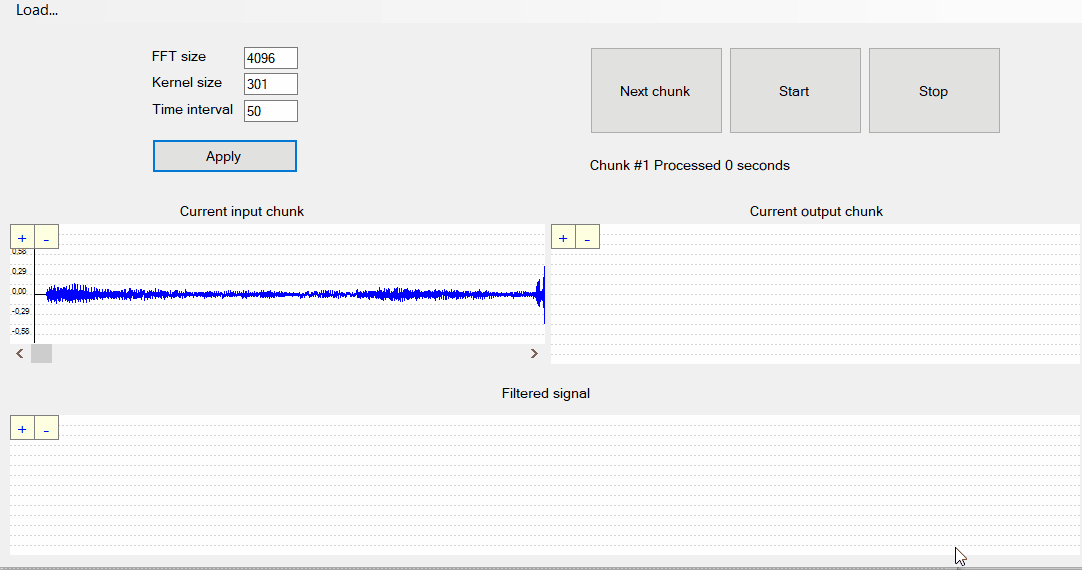
Feature extractors
Highly customizable feature extractors are available for offline and online processing (MFCC family, LPC, pitch and lot of others).
var mfccOptions = new MfccOptions
{
SamplingRate = signal.SamplingRate,
FeatureCount = 13,
FrameDuration = 0.032/*sec*/,
HopDuration = 0.015/*sec*/,
FilterBankSize = 26,
PreEmphasis = 0.97,
//...unspecified parameters will have default values
};
var mfccExtractor = new MfccExtractor(mfccOptions);
var mfccVectors = mfccExtractor.ComputeFrom(signal);
// serialize current config to JSON file:
using (var config = new FileStream("file.json", FileMode.Create))
{
config.SaveOptions(mfccOptions);
}
var lpcOptions = new LpcOptions
{
SamplingRate = signal.SamplingRate,
LpcOrder = 15
};
var lpcExtractor = new LpcExtractor(lpcOptions);
var lpcVectors = lpcExtractor.ParallelComputeFrom(signal);
var opts = new MultiFeatureOptions
{
SamplingRate = signal.SamplingRate,
FeatureList = "centroid, flatness, c1+c2+c3"
};
var spectralExtractor = new SpectralFeaturesExtractor(opts);
opts.FeatureList = "all";
var tdExtractor = new TimeDomainFeaturesExtractor(opts);
var vectors = FeaturePostProcessing.Join(
tdExtractor.ParallelComputeFrom(signal),
spectralExtractor.ParallelComputeFrom(signal));
// each vector will contain 1) all time-domain features (energy, rms, entropy, zcr)
// 2) specified spectral features
// open config from JSON file:
PnccOptions options;
using (var config = new FileStream("file.json", FileMode.Open))
{
options = config.LoadOptions<PnccOptions>();
}
var pnccExtractor = new PnccExtractor(pnccOptions);
var pnccVectors = pnccExtractor.ComputeFrom(signal, /*from*/1000, /*to*/60000 /*sample*/);
FeaturePostProcessing.NormalizeMean(pnccVectors);
// serialization
using (var csvFile = new FileStream("mfccs.csv", FileMode.Create))
{
var serializer = new CsvFeatureSerializer(mfccVectors);
await serializer.SerializeAsync(csvFile);
}
Pre-processing
// There are 3 options to perform pre-emphasis filtering:
// 1) Set pre-emphasis coefficient in constructor of a feature extractor
// 2) Apply filter before processing and process filtered signal
// 3) Filter signal in-place and process it
// (...read more in docs...)
// option 1:
var opts = new MfccOptions
{
SamplingRate = signal.SamplingRate,
FeatureCount = 13,
PreEmphasis = 0.95
};
var mfccExtractor = new MfccExtractor(opts);
var mfccVectors = mfccExtractor.ComputeFrom(signal);
// option 2:
// ApplyTo() will create new signal (allocate new memory)
opts.PreEmphasis = 0;
mfccExtractor = new MfccExtractor(opts);
var pre = new PreEmphasisFilter(0.95);
var filtered = pre.ApplyTo(signal);
mfccVectors = mfccExtractor.ComputeFrom(filtered);
// option 3:
// process array or DiscreteSignal samples in-place:
for (var i = 0; i < signal.Length; i++)
{
signal[i] = pre.Process(signal[i]);
}
// or simply:
// pre.Process(signal.Samples, signal.Samples);
mfccVectors = mfccExtractor.ComputeFrom(signal);
Playing and recording
MciAudioPlayer and MciAudioRecorder work only at Windows-side, since they use winmm.dll and MCI commands.
IAudioPlayer player = new MciAudioPlayer();
// play entire file
await player.PlayAsync("temp.wav");
// play file from 16000th sample to 32000th sample
await player.PlayAsync("temp.wav", 16000, 32000);
// ...in some event handler
player.Pause();
// ...in some event handler
player.Resume();
// ...in some event handler
player.Stop();
// recording
IAudioRecorder recorder = new MciAudioRecorder();
// ...in some event handler
recorder.StartRecording(16000);
// ...in some event handler
recorder.StopRecording("temp.wav");
Samples


